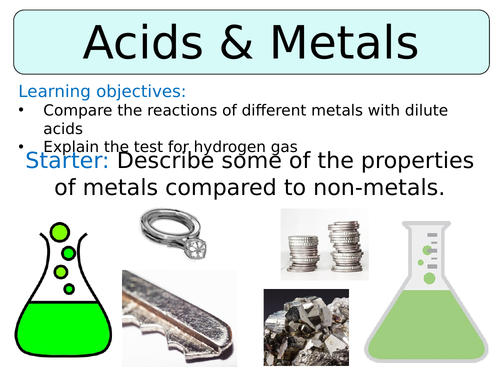
This lesson is designed for the KS3 Year 8 Science course, specifically the C2 1.2 unit on ‘Metals & Other Materials’.
For more lessons designed for KS3 and KS4 please visit my shop at: https://www.tes.com/teaching-resources/shop/SWiftScience.
This lesson begins with an introduction to the three main acids and their chemical formulae - nitric acid, hydrochloric acid and sulphuric acid - students are asked to identify what the three compounds have in common. Students should hopefully identify that they are contain hydrogen atoms.
This then leads onto the next slide where students are introduced to the idea of a salt - the compound which forms when an acid and a metal react together. Students are given some information about this reaction and about salts, using this information students will need to answer some questions. Once this task has been completed, students can self-assess their work using the mark scheme provided.
Students will then watch a video of a metal reacting with an acid, whilst students watch this video they are asked to write down any observations they make about the reaction, as well as think about what is happening that we can’t see/hear/feel.
Students are now shown the word equation for magnesium metal reacting with hydrochloric acid and zinc metal reacting with hydrochloric acid, students are asked to think about the pattern with the products formed from these reactions. Hopefully, students can identify that a salt + hydrogen is formed in each one. Students are now asked to copy and complete a set of word equations for several more metal + acid reactions. This work can be self-assessed once complete.
Next, students will conduct an investigation into how different metals react differently with acids. Students will test five metals - copper, iron, zinc, lead and magnesium - with hydrochloric acid. Hopefully, by completing this investigation they will be able to successfully place the metals in order of reactivity, this can be checked using the answers provided on the PowerPoint.
Lastly, students need to be able to describe the test for hydrogen gas. Students will firstly be asked to ‘Think > Pair >Share’ their ideas about how this may be carried out, before watching a video to check whether their ideas were correct. Students can then make a note of this test in their books.
The plenary task requires students to write a list of key words which were learned in the lesson today.
All resources are included at the end of the presentation. Thanks for looking, if you have any questions please let me know in the comments section and any feedback would be appreciated :)
Get this resource as part of a bundle and save up to 31%
A bundle is a package of resources grouped together to teach a particular topic, or a series of lessons, in one place.
Something went wrong, please try again later.
This resource hasn't been reviewed yet
To ensure quality for our reviews, only customers who have purchased this resource can review it
Report this resourceto let us know if it violates our terms and conditions.
Our customer service team will review your report and will be in touch.
